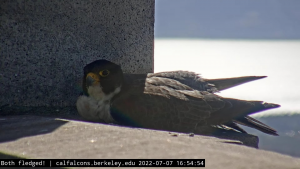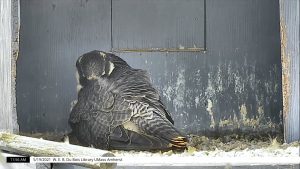About Falcons
7 Other Behaviors
Lauren Weiss
Loafing

According to the scientists at UC Berkeley, loafing is “the scientific term for when a bird is displaying relaxed behaviors not specifically related to feeding, breeding, or predator evasion.”
Panting
Falcons keep themselves cool the same way dogs do, by panting.
Sleeping

Peregrine falcons are diurnal, which means they are active during the day, unlike owls and other animals which are nocturnal, or active at night.
When birds sleep, they fluff out their feathers, turn their head around, tuck their beak into their back feathers, and pull one leg up to their belly. This is because they have down feathers, which are short, fluffy feathers underneath their sleek outer feathers that hold in heat to keep them warm. By tucking in their beak and legs, the birds keep those parts warm under the down feathers, even as it gets colder at night.
How can birds sleep while holding onto a perch? They don’t fall off because when they put weight on their feet, their leg muscles make their feet tendons tighten and keep their feet locked in position.
Peregrine falcons also do something called unihemispheric slow-wave sleep (USWS). This is where a bird sleeps with half of their brain alert and half of it asleep, so actually sleeping with one eye open. This is useful to birds because it lets them get the rest they need while also staying alert in case a predator approaches. As a matter of fact, there are some birds that even do USWS while they are migrating so they can sleep and fly at the same time!
Media Attributions
- Loafing © Cal Falcons, University of California Berkeley is licensed under a CC BY (Attribution) license
- Sleeping Peregrine Falcon © UMass Amherst Libraries is licensed under a CC BY (Attribution) license

